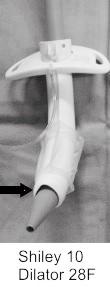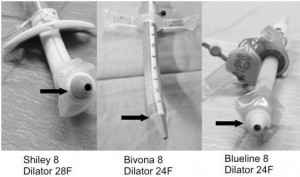Amer Majeed, FCARCSI*, Santhana Kannan, FRCA**
*Specialist Registrar, Blackpool Teaching Hospitals, Blackpool (United Kingdom)
**Consultant Anaesthetist and Intensive Care, Sandwell and West Birmingham NHS Trust, Birmingham (United Kingdom)
Correspondence: Dr A. Majeed, FCARCSI, Specialist Registrar, Blackpool Teaching Hospitals, Blackpool (United Kingdom); e-mail: amer.majeed@gmail.com
SUMMARY
Percutaneous tracheostomy is a common procedure in intensive care unit. The different diameters of loading dilators in the standard Blue Rhino percutaneous tracheostomy kit and available tracheostomy tubes means that difficulties may be encountered during the procedure due to formation of a ‘step’ between the tube and the loading dilator. This increases the potential for complications and might add to the cost. In order to find out the best combination of tracheostomy tubes and loading dilators, this study compared the various tracheostomy tubes. Size 8 of all tracheostomy tubes had the best fit when used with specific loading dilators in the standard Blue Rhino Kit. It is recommended that a size 8-tracheostomy tube be chosen with the standard Blue Rhino technique for percutaneous tracheostomy. If a smaller tube is deemed necessary, a size 7 will provide a good fit.
Key Words: Percutaneous tracheostomy; Blue Rhino; Tracheostomy tubes; Loading dilators
Citation: Majeed A, Kannan S. Diametrical differences between Blue-Rhino® kit loading dilators and percutaneous tracheostomy tubes. Anaesth Pain & Intensive Care;15(3):—-
INTRODUCTION
Percutaneous Dilatational Tracheostomy (PDT) is a common procedure performed on critically ill patients in intensive care. Ciaglia Blue RhinoTM (Cook, 5690 AE Son, The Netherlands) is the most popular PDT set used in the United Kingdom (1) and is currently the standard choice in our unit. Among other contents, the standard Blue Rhino kit (manufacturer’s package reference: C-PTIS-200-WCE-HC) 2 contains three soft loading dilators of varying outer diameters (OD), i.e. 21F (7 mm), 24F (8 mm) and 28F (9.3 mm). PDT technique involves introduction of a guide wire into the trachea followed by dilatation using a variable diameter single dilator (the Blue Rhino) and passage of the tracheostomy tube loaded over one of the three loading dilators. The standard kit does not come prepackaged with a tracheostomy tube although combined sets are available.
Informal survey among the practitioners in our unit revealed that difficulty in insertion of the tracheostomy tube after percutaneous dilatation is common. An ‘escalated step’ between the loading dilator and the tracheal tube due to mismatch in diameters of the tracheal tube and the loading dilator is the cause of this difficulty. Occasionally, this has produced deformation of the tracheostomy tube (Fig 1), further increasing the risk of traumatic complications such as a false passage, posterior tracheal wall perforation, or fracture of the tracheal rings3. We have noted this anomaly on several occasions and tracheostomy tubes have been wasted due to repeated failed attempts caused by the lack of a good ‘fit’ with the loading dilators. We conducted a simple study to find out the best combination of loading dilators and tracheostomy tubes that avoided the ‘escalated step’ to minimize the potential for tracheal trauma.
METHODOLOGY
We chose four different brands of tracheostomy tubes in three different sizes. These were: Shiley® tracheostomy tubes of sizes 6, 8 and 10 (Tyco Healthcare UK Ltd, Gosport, UK); Bivona® Hyperflex Adjustable Flange sizes 7, 8 and 9; Portex® Blue-Line adjustable Flange sizes 7, 8 and 9; and Bivona® Fome-Cuff sizes 7, 8 and 9. The last three come from the same manufacturer (Smiths Medical International Limited, Kent, UK). The tubes were sequentially loaded on the three standard loading dilators and any ‘escalated step’ equivalent to a diametrical mismatch visuallised was noted for each combination. The combination having best fit with the available loading dilators was noted for each of the tubes. This was verified by consulting the measurements published in the accompanying product information sheets.
Fig 1: Size 10 Shiley loaded over 28F loading dilator leaves an ‘escalated step’. Note the deformity (Arrow) caused by the ‘step’ during the process of insertion of the tube.
Fig 2: Best fit combinations: Size Shiley 8 and 28F loading dilator; Size 8 of both Bivona Hyperflex and Portex Blue line Adjustable flange with 24F loading dilator. There is no gap between the loading dilator and the tube (Arrows).
All types of tracheostomy tubes of size 8 have the best fit as their internal diameter matched the diameter of loading dilators in Blue Rhino kit (Fig 2). The only difference is the choice of loading dilator to be used where a Shiley 8 requires 28F and others require 24F (Table 1).
Table 1: Best fit combinations of different tracheostomy tube sizes to be used with the loading dilators in the Standard Blue Rhino Kit.
| Loading dilator Size | 21F | 24F | 28F |
| Shiley | – | 6 | 8 |
| Bivona Fome cuff | 7 | 8 | – |
| Portex Blue Line® Adjustable Flange | 7 | 8 | – |
| Bivona Hyperflex™ | 7 | 8 | – |
Size 7 of all the tubes has a good fit except Shiley to match the 21F introducer (Table 1). All other sizes have varying degrees of ‘escalated step’ with any combination of loading dilators. Bivona Hyperflex size 9 has an additional issue in the form of insufficient length of the loading dilators although a modification of the technique of insertion has been reported to get around this problem4.
DISCUSSION
During PDT, it is important to get the correct combination of the tracheostomy tube and the Blue Rhino loading dilator, to minimize the duration and number of attempts, traumatic potential and tube wastage. The presence of only three sizes of loading dilators means that only certain combination of tubes will be a good choice. It would have been ideal if the loading dilators in the standard Blue Rhino PDT kits matched all the available tracheostomy tubes although this is likely to push up the cost.
Our study shows that a size 8 tube should be the first choice if the standard Blue Rhino Kit is used for PDT. If a smaller tracheostomy size is deemed necessary, a size 6 of Shiley or size 7 of other brands of tubes should be used. This approach will minimize wastage of resources by avoiding opening numerous tubes to find the best fit.
Ciaglia Blue Rhino PDT tracheostomy tube custom sets are available2. These sets have a single size Tracoe twist tracheostomy tube (TRACOE medical GmbH, Frankfurt/Main, Germany) with an appropriate size dilator. A new product is also available (TRACOE experc PDT set, TRACOE medical GmbH, Germany), which has a collapsible silicone sleeve at the introducer tip. This virtually eliminates the step and in theory, should aid easy insertion of any size tube, but again the choice of tracheostomy tubes becomes limited to the one supplied; and complications have been reported with this set too5.
An issue which might cause confusion is about the best fit of an apparently smaller Shiley (Nellcor Puritan Bennett LLC.) size 8 (ID 7.6 mm) fitting over a larger 28F introducer (9.3 mm OD). The explanation lies in the terminology used. The tube sizes are indicated by the ID of inner tubes in Shiley. Hence, the inner diameter of a size 8 Shiley inner tube is 7.6 mm. However, during PDT, the inner tube is removed. The ID of the outer tube is 9.3 mm which fits well over a similar diameter 28F introducer6. This is not an issue with other tubes that do not have an inner tube.
REFERENCES
- Krishnan K., Elliot SC, Mallick A. Current practice of tracheostomy in the UK. Anaesthesia 2005;60:360–364
- Product brief: Ciaglia Blue Rhino Percutaneous Tracheostomy Introducer Set. Cook, 5690 AE Son, The Netherlands. William Cook Europe 2002
- Bewsher MS, Adams AM, Clarke CWM, McConachie I, Kelly IDR. Evaluation of a new percutaneous dilatational tracheostomy set. Anaesthesia 2001;56:859-864
- Watters M, Waterhouse P. Percutaneous tracheostomy in morbidly obese patients. Anaesthesia 2002; 57:614-615
- Saxena N, Greenway I, Harding LJ, Davies NG. A complication of the ‘atraumatic inserter’ of the Tracoe experc percutaneous dilation tracheosotmy set. Anaesthesia 2008;63:1372–1386
- Ahma I, Loveland RC, Rangasami J. Variability in tracheostomy tubes. Anaesthesia 2007; 62:535



